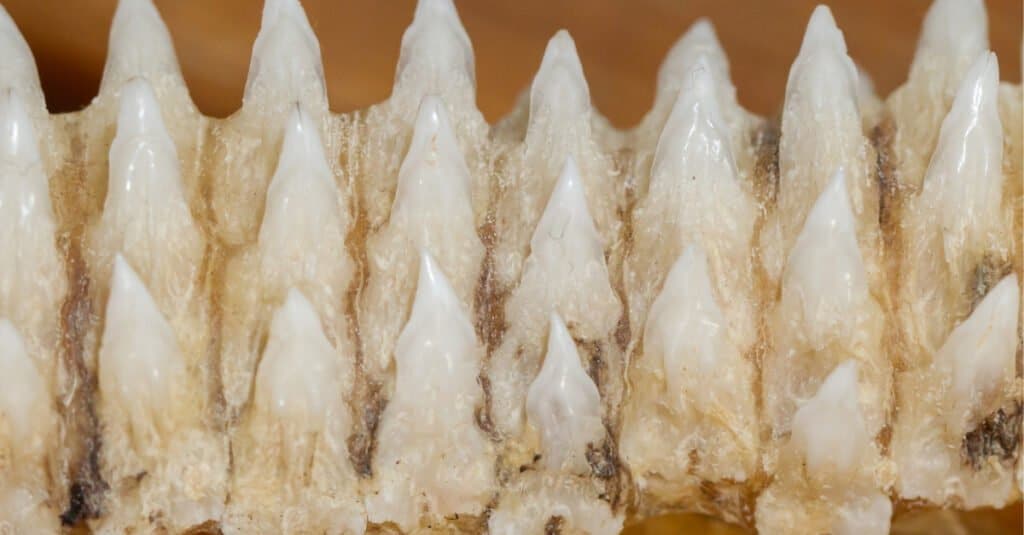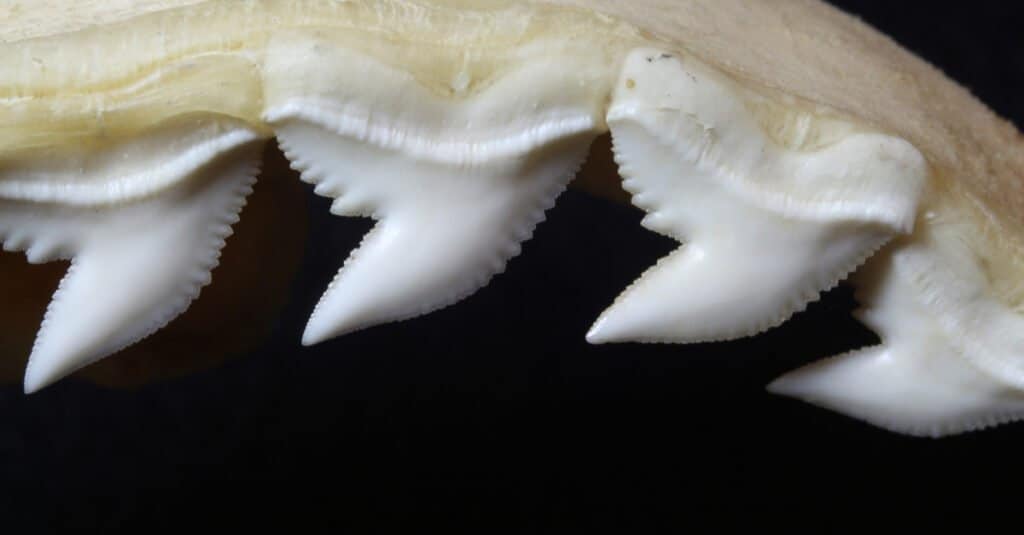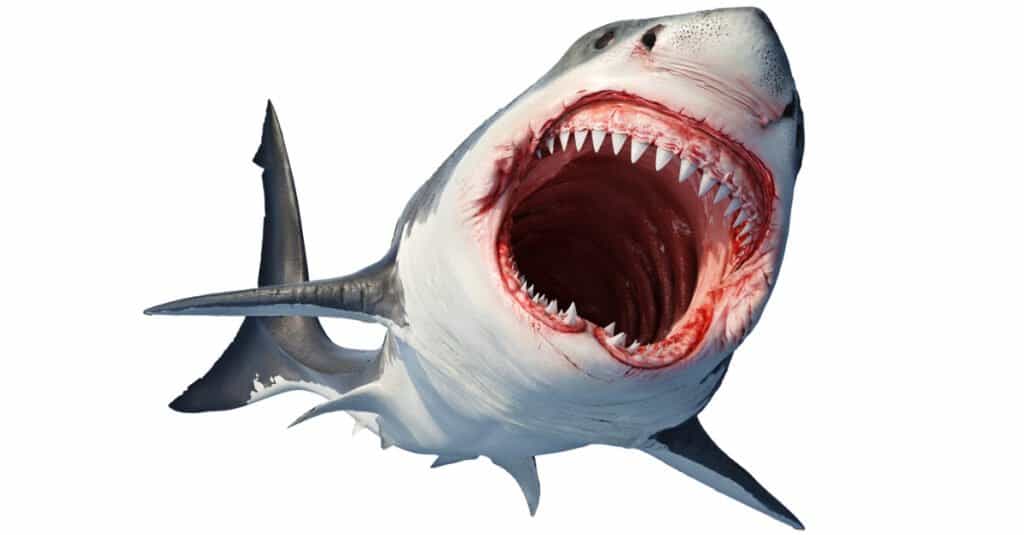Sharks are amazing creatures that live in the sea. Surprisingly, they have unusual body structures compared to other aquatic animals like dolphins and piranhas. These enormous aquatic creatures are far more than a predator; they are also the balancing component of the ecosystem.
Most of the time, we believe we know everything there is to know about sea creatures, but more often than not, new facts emerge. How much do we truly know about sharks? Discover the truth to one of the most often asked questions about these marine animals: how many bones do sharks have?
Are Shark Teeth Made Of Bones?

Shark teeth are composed of calcium phosphate.
©iStock.com/MyImages_Micha
No, shark teeth are not bones. They are different from bones. Surprisingly, shark teeth are composed of calcium phosphate, which is lighter than actual bone. The beautiful teeth of this fantastic ocean dweller are as distinct as the entirety of its body, but they do not sit in the mouth like the human teeth. Intriguingly, sharks shed their teeth regularly, like deer shed their antlers and snakes shed their skins. They lose roughly one precious tooth every week on average, making them have about 35,000 teeth throughout their lifespan. Nevertheless, since the teeth are not affixed to the jaw, it is safe to assume that shedding their teeth is painless, as opposed to the human teeth.
What Are Sharks’ Teeth Shaped Like?

The shape of a shark’s tooth is determined by its feeding and hunting activities.
©Matthew R McClure/Shutterstock.com
A shark’s feeding and hunting activities determine its tooth shape. Fascinatingly, the strong, serrated triangular teeth of the great white shark, for example, are outstanding for crushing and tearing up prey. On the other hand, the gentle nurse shark has flat, conical teeth that are designed to devour smaller crustaceans. So, the shape and serrations of a shark’s tooth can help identify the species of the shark.
How Many Bones Do Sharks Really Have?

Sharks do not have bones.
©iStock.com/ARTYuSTUDIO
A shark does not have bones, but this gigantic aqua critter is cartilaginous, so by default, its skull, jaw, spinal cord, and teeth are all made of cartilage, a similar tissue that makes up a human’s nose and ears. Since cartilages are much lighter than bones, they allow this flexible marine animal to glide through the water like a torpedo. Another striking difference between cartilage and bones is that the latter has blood arteries while the former does not.
How Do Sharks Live Without Bones?
How sharks survive without the conventional red blood cells formed in bone marrows remains a mystery. Nevertheless, they live because their unique blood is produced in the spleen, epigonal organ, and also created in the Leydig’s organ, which is exclusively present in Chondrichthyes fish like skates, rays, and sawfish. So, while terrestrial animals like lions and humans need bones to support their movement on land, these huge oceanic predators require cartilages to survive in the marine world.
How Do Sharks Cartilage Help Them Adapt to Hunting?
Over the years, different researchers questioned the advantages of cartilage over bones. Interestingly, they began to access the advantages of cartilage skeletons to understand how they evolved. Researchers found that sharks remained substantially unchanged because their cartilaginous skeletons had incredible advantages that helped with their marine adaptation. These advantages include:
- Weight minimization: Cartilage is tough and dense, although not as heavy as bone. Interestingly, it is easier for sharks to swim at high rates with this cartilage, propelling them to become extremely efficient predators.
- Cartilages are buoyant: Unlike other bony fish, sharks do not require swim bladders to maintain neutral buoyancy due to their lightweight cartilage-based skeleton. Amazingly, they have more energy for propulsion because they do not have to exhaust extra energy to stay afloat. Another stunning benefit of buoyancy allows them to save energy for their hunting sprees.
- Flexibility: No doubt, cartilages are bendable. But, animal skeletons that consist majorly of bones strongly depend on cartilage at some point in their joints to bend and flex. For sharks, their complete skeleton made of cartilage enables them to turn and move faster when hunting prey.
- Bite force: Predatory animals like sharks, crocodiles, and bears have the deadliest bite force of any living creature. However, for sharks, the force of their bites can be attributed to their cartilaginous skeleton because it permits their jaws to be more flexible and it is intimately connected to the musculature. The powerful bite force allows sharks to destroy their prey faster while exhausting less energy.
- Thick Skin: Sharks skin protects them by functioning like an exoskeleton while remaining flexible.
Are Sharks Vertebrates?
Vertebrates, which include mammals, birds, reptiles, amphibians, and fish, are members of a vast group of animals characterized by a backbone or spinal column. Sharks are unmistakably vertebrates, despite their lack of bones.
Two enormous, tube-like sections of cartilage form their exceptional spinal columns. Interestingly, it protects their spinal cord the same way the one made of bones does.
What Are Sharks Scales Made Of?
Sharks have been genetically predisposed to evolve as great creatures endowed with unique features. They are covered in scales; however, they are not the same as those found on other fish ( since they do not lay flat on their skin). Their microscopic tooth-like scales are called dermal denticles, and they assist them navigate faster in the water while influencing drag and thrust in hunting fast-moving prey. Sharks swim through the water with their scales pointing outwards and upwards while creating a rippling effect.
Is Eating Shark Legal in the United States?
In certain parts of the United States, people consume shark meat because sharks produce a lot of meat due to their gigantic body mass. However, it is not particularly popular in the United States since several species located off the coast are endangered, and shark meat has been reported to have high levels of mercury. Most shark hunters resort to finning.
What Exactly is Finning?
While eating shark fins isn’t a problem for most people, shark finning is nevertheless a problem for sharks worldwide. Sadly, the human race has been cruel to aquatic creatures, including sharks. The process of unremorsefully capturing innocent sharks, removing their fins, and brutally releasing them back into the water alive is known as finning. The pathetic finless sharks are rendered utterly powerless, sinking to the ocean floor and suffocating or eaten by other fishes. This brutal finning wastes 95% of the animal’s meat. Due to fins’ monetary and cultural value, many fishermen believe it is more cost-effective to save room on their boats by bringing only the fins back to shore rather than the complete shark.
The photo featured at the top of this post is © iStock.com/BWFolsom
Thank you for reading! Have some feedback for us? Contact the AZ Animals editorial team.






